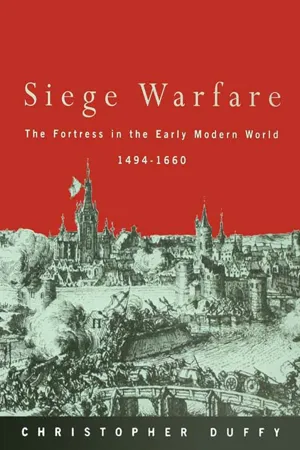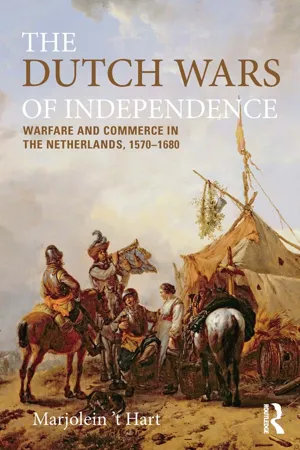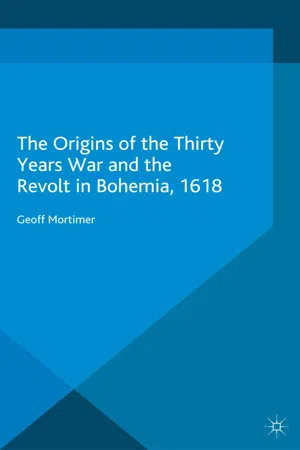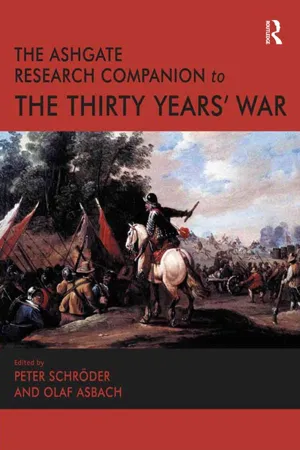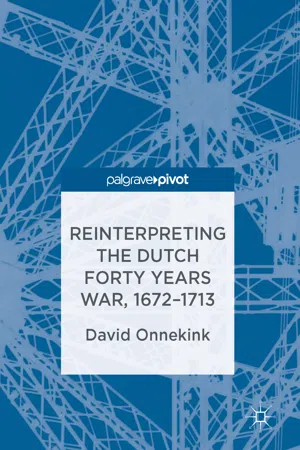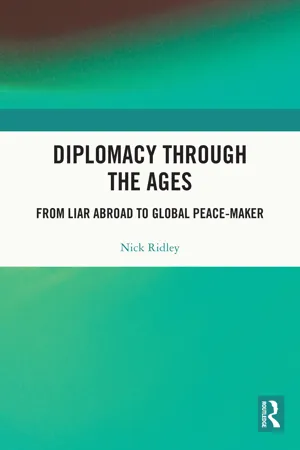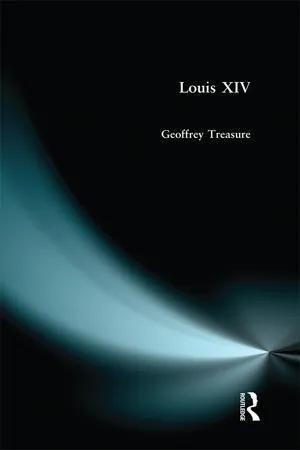History
Eighty Years War
The Eighty Years' War, also known as the Dutch War of Independence, was a protracted conflict between the Spanish Empire and the Dutch Republic from 1568 to 1648. It resulted in the independence of the Dutch Republic and marked a significant shift in the balance of power in Europe. The war also had religious and economic dimensions, with the Dutch Revolt being a key factor in the conflict.
Written by Perlego with AI-assistance
Related key terms
7 Key excerpts on "Eighty Years War"
- eBook - ePub
Siege Warfare
The Fortress in the Early Modern World 1494-1660
- Christopher Duffy(Author)
- 2013(Publication Date)
- Routledge(Publisher)
Four The Eighty Years War in the Netherlands 1566–1648The conditions of the struggle
‘The war in the Netherlands is the biggest, bloodiest and most implacable of all the wars which have been waged since the beginning of the world’ (quoted in Villa, I904, 473). So exclaimed the Spanish councillor of state Fernando Giron in I627, when the war between Spain and the young Dutch state had already lasted sixty years, and still had twenty more to run.This struggle was of the first importance in the history of fortress warfare. These eight decades witnessed not just the further development of the new shapes of fortification which had first evolved in Italy, but the elevation of the siege attack to the status of a science. Such advances were given a European currency, for the Lowlands Wars were considered ‘the nursery of the militia’ (Hexham, 1642–3, dedication).The human interest was also remarkable. The sieges of places like Haarlem and Ostend rivalled the most bitter episodes of the Turkish wars or the Peninsular War in desperate obstinacy, and they outmatched them in active, inventive bravery, which was a much rarer quality.The groundThere are a number of geographical and military constants which go far to explain why the Eighty Years War was fought at such length and with such determination. Most obviously, there was the system of river barriers and associated obstacles — inundations, wastelands, forts and blockhouses — which cramped the movement of the field armies.The Spanish Netherlands of the third quarter of the sixteenth century comprised present-day Holland and Belgium. Dutch nationhood had its roots in the natural redoubt formed by the seaward provinces of Holland and Zeeland. Here the rebels found a secure retreat during the crisis of the revolt in I572 and I573, for - eBook - ePub
The Dutch Wars of Independence
Warfare and Commerce in the Netherlands 1570-1680
- Marjolein 't Hart(Author)
- 2014(Publication Date)
- Routledge(Publisher)
1Military eventsFrom the Dutch Revolt to ‘la Guerre de Hollande’, c. 1570–c. 1680We are destroyers of citadels but builders of free cities.1The war that became known as the Dutch Revolt or the Eighty Years War started as a series of minor revolts in the Low Countries against the lawful overlord, Philip II King of Spain. The movement gained ground as towns and whole provinces allied themselves to the rebels and by the 1580s the Dutch Republic was firmly institutionalized. The military confrontation proved to be extended, lasting many decades – not least because the terrain, by nature already intersected with waters and marshy grounds, was additionally dotted with numerous fortresses and strongly fortified towns. Any military operation in this area was doomed to lose momentum before long; in a couple of months defenders (from either side) were able to regain their strength. That the terrain was stronger than man was shown on numerous occasions: during the Spanish advances of 1573 and 1629 in the north and the Dutch campaigns of 1568 and 1635 in the south, and again in 1672 when the French invasion was forced to stop short at Holland’s provincial borders. Not only the terrain but also the capacities of the belligerents caused the Dutch Wars of Independence to last so long. The Spanish monarchy drew enormous resources from its imperial base, while the Dutch had the advantage of outstanding logistics as part of their war finances and a burgeoning economy. What follows is an overview of the most significant political and military developments, concluded by a summary of the contrasting strategies of the belligerents. The chapter also provides essential context for the other chapters of this book.The Dutch Revolt and the struggle for survival, 1570s to 1580sBeing one of the wealthiest and most urbanized regions of Europe, the Low Countries cherished their ‘liberties and privileges’ under Spanish-Habsburg rule. Emperor Charles V had just united the 17 provinces in 1549 (see Figure 1.1 ). The relationship between the overlord and his subjects was one of fluctuating loyalty and criticism. After the abdication of Charles V, criticism directed against his son Philip II intensified. Like all other major upheavals, the Dutch Revolt was caused by a mix of unstable conditions and highly varied discontent that involved several layers of society at the same time. After repeated large-scale open-air Calvinist sermons and iconoclast outbursts had threatened Catholic rule, the Spanish king sent the Duke of Alva in 1567 as the new governor-general to restore order. Alva was convinced that his work of pacification would be a matter of just a couple of months, not least because of the numerous factional divisions in the Low Countries, but also because the Spanish troops were at that time Europe’s largest, best trained and best equipped military force.2 The duke was known for his ruthless attitude towards his enemies and within a short time his ‘Council of Blood’ had over a thousand of the regime’s ‘adversaries’ executed, among others the counts of Egmond and Hoorn, who belonged to the highest nobility.3 - Geoff Mortimer(Author)
- 2015(Publication Date)
- Palgrave Macmillan(Publisher)
4 Shortly before the Bohemian revolt the later Emperor Ferdinand II, then archduke of Styria, was fighting Venice in the Uzkok war, while the duke of Savoy was fighting the Spanish in northern Italy in the second stage of the Mantuan War of Succession, and Gustavus Adolphus was already fighting the Poles in Livonia. Between 1619 and 1621, during the war in Bohemia, there was civil war in France, Poland was skirmishing with the Turks and with Bethlen Gabor, prince of Transylvania, who was himself fighting the emperor, and the Spanish were occupying the Valtelline in the Swiss canton of Graubünden. Particularly problematic in this context is the status of the war between Spain and the United Provinces, which commenced in 1568 after the initial revolt in the Spanish Netherlands two years earlier, but which was in abeyance, at least on land in Europe, during a truce from 1609 to 1621. The years leading up to the outbreak of the Thirty Years War were thus also the years leading up to the widely expected resumption of war in the Netherlands, but whether these were separate issues or different facets of the same one posed interpretational problems for contemporaries and subsequent historians alike.The international situationThe rivalry between France and Spain was the most important single aspect of international relations in Europe throughout most of the sixteenth and seventeenth centuries. This rivalry had its own history, but even longer established and more intense had been the rivalry between the French monarchy and the dukes of Burgundy. The two issues became entwined, together with the Habsburg connection, through a series of inheritances, some sought-after and others accidental, in the latter years of the fifteenth and early years of the sixteenth centuries. In 1477 Duke Charles the Bold of Burgundy died at Nancy in the last battle of the Burgundian Wars with France, following which the French seized Burgundy itself, but his Netherlands possessions, principally modern Belgium and Holland, passed to his only surviving child, the 19-year-old Mary. She promptly married the Habsburg Archduke Maximilian of Austria, the later Emperor Maximilian I, and after her own early death in a riding accident their son, known as Philip the Handsome, inherited the Netherlands, becoming ruler when he reached the age of 16 in 1494. Two years later Philip married a Spanish princess, Joanna of Castile, a good but not spectacular marriage, as she was only the third child of Ferdinand II of Aragon and Isabella of Castile, but following two unexpected deaths and much political in-fighting she inherited Castile in 1506 and Aragon in 1516. By then Philip was already dead, having predeceased his father the emperor, and as Joanna was deemed to be mad their 16-year-old son became co-ruler and regent, as well as inheriting Habsburg Austria and being elected emperor as Charles V soon afterwards, in 1519.- Olaf Asbach, Peter Schröder(Authors)
- 2016(Publication Date)
- Routledge(Publisher)
When the Spanish and Dutch ambassadors ratified their part of the cluster of related agreements in the Treaty of Westphalia, they ended a conflict that had originated more than 80 years earlier as the Dutch Revolt (1566–1648). By 1618, however, even the hawks in Madrid acknowledged that there was little or no hope of forcing the Dutch provinces back into the Spanish fold. Spain was an empire on the defence, drawn into the emerging cluster of military conflicts that would become the Thirty Years’ War not so much by aggressive imperialism as by a number of distinct yet nonetheless closely related issues: firstly, dynastic loyalty to their Austrian Habsburg relatives, a motive inextricably linked to the political structure and confessional balance of the Holy Roman Empire; secondly, the perceived need to maintain the ‘Spanish Road’, the vital connection between the Spanish Netherlands and the military resources of northern Italy; thirdly, even the less militant factions at the Madrid court appreciated that a need to protect the monarchy’s interests and territories by anticipating and averting possible damage to Spanish prestige or reputación. In many respects, the final Peace of Münster only confirmed the status quo ante bellum. Yet the decades of conflict had tested the Spanish monarchy to its limits, and its structures, means and identities were compelled to adjust to events and to the pressures of incessant global conflict. The Dutch Republic, in turn, not only asserted its sovereignty but adapted to the challenges of war by gradually establishing its own imperial identity and ideology in both theory and practice. Olaf van Nimwegen’s chapter follows the watersheds of the final phase of this ‘Eighty Years War’ and traces its manifold impact on these two very different powers and their relations with their European neighbours and the Holy Roman Empire in particular. Sven Externbrink’s chapter analyses the role played by Italy during the Thirty Years’ War- David Onnekink(Author)
- 2017(Publication Date)
- Palgrave Pivot(Publisher)
© The Author(s) 2016 David Onnekink Reinterpreting the Dutch Forty Years War, 1672–1713 10.1057/978-1-349-95136-9_4Begin Abstract4. The Nine Years’ War (1688–1697)
David Onnekink 1(1) Department of History, University of Utrecht, Utrecht, The NetherlandsAbstractIn this chapter, David Onnekink analyses foreign policy discourses at the start of the Nine Years’ War (1688–1697). Historiography has emphasized the strategic aim of William III in 1688 to redress the balance of power, endorsed a secular realist paradigm of French expansionism and downplayed the relevance of political parties. In this chapter, Onnekink compares three categories of primary sources: political documents, formal published documents and popular publications. He argues that the two partisan foreign policy discourses of 1672 continued to develop. Republicans ignored domestic differences and rehashed their traditional Two Kings Discourse that became deadlocked in 1688. Orangists developed Universal Monarchy Discourse and Religion and Liberty Discourse and ignored the balance of power.Keywords Nine Years’ War Foreign policy Dutch Republic Louis XIV William III Universal monarchyEnd AbstractIntroduction
One of the most remarkable aspects of the historiography of 1688 is the relative lack of interest among Dutch historians. Although there has been some attention for the ‘glorious expedition’, Dutch foreign policy on the eve of the Nine Years’ War and the Glorious Revolution lacks a scholarly monograph.1 Moreover, in general overviews on Dutch foreign policy this era is almost passed over.2Nevertheless, several articles have discussed the Dutch role in the Glorious Revolution, which developed five alternative interpretations. The first interpretation is strategic. According to Simon Groenveld, William’s intervention in England can be explained by a desire to restore the balance of power in Europe by turning England into an ally against France.3 A second view was proposed by Jonathan Israel, who drew attention to the impact of the French guerre de commerce as a cause for war, in addition to strategic considerations.4 A third interpretation was put forward by Lucille Pinkham, who argued that William fought for the English throne. Although her interpretation has found no support, there have been other historians who have emphasized the dynastic dimension of 1688.5 A fourth view was defended by Stephen Baxter and Andrew Lossky, who argued that William safeguarded the liberties of Europe.6 Finally, Murk van der Bijl and other historians presented William as a champion of Protestantism.7 It seems safe to say that the first, strategic, interpretation is dominant, and that the others have been invalidated, rejected or marginalized by historians. Peter Rietbergen probably voiced a consensus view that:the only political issue that really counted for William was the equilibrium of Europe, the freedom of the European states – first and foremost of the Dutch Republic. Freedom, that is, from any form of hegemony which might threaten political and religious autonomy. Because the main threat to that autonomy was France, and, through it, state-dominated Catholicism, Protestantism became an issue as well – though, perhaps, to William a slightly more collateral one.8- eBook - ePub
Diplomacy Through the Ages
From Liar Abroad to Global Peace-maker
- Nick Ridley(Author)
- 2022(Publication Date)
- Routledge(Publisher)
2 The Thirty Years’ WarDOI: 10.4324/9781003258780-2The Reformation caused religious turbulence in Europe and produced a virulent reaction by the Catholic Church. By the mid-sixteenth century the Catholic Church, led by zealous and practical popes, underwent an internal reform process, reasserting and enforcing the fundamental values and practices amongst its clergy. However, it also took the offensive. New religious orders formed, particularly the Society of Jesus, the Jesuits, whose members were rigorous adherents to doctrine, well trained and militant. Their objectives were not only to reclaim the lost spiritual ground within Europe but also activities abroad in politics, subverting subjects in Protestant countries from their loyalties to the state. As a major part of this Catholic counter-offensive, Spain, under its Kings, placed itself at the head of the political Counter-Reformation.The Dutch Republic consisting of the seven northern provinces, had gained de facto independence after a long and protracted struggle with Spain under the terms of the 1609 Twelve Years’ Truce. Maurits of Nassau, coming to office at a time of crisis, had ensured by his military and leadership skills the survival of the Dutch Republic. But in the decade of peace the Dutch Republic was divided by complex religious controversy, which had causing significant divisions and a power struggle, ending in Maurits restoring order by military action.Despite the internal turmoil the Dutch economy had expanded exponentially, and Dutch overseas trade – and conquests at the expense of Spain and Portugal – brought in large trading revenues. Rivalry with the northern Baltic powers of Denmark and Sweden had resulted in the Dutch so far winning the trade war unscathed. For now. The Dutch Republic had some tenuous links with the Holy Roman Empire. Some territory of the Dutch Republic and the Spanish Netherlands, legally formed part of the Holy Roman Empire as the Burgundian Circle (the Holy Roman Empire was divided into administrative and military districts known as Circles). Also during the Dutch Revolt in the mid-1570s, Mattias, son of the late Emperor Maximilien II, was called in as a possible mediator.1 - 9 Later, as the value of colonies was perceived and commercial interests became more influential, economic factors become more prominent.In each war, of course, there were allies with different agendas. Within both countries there were differences over war aims and priorities: in 1701-13, for example, in France about the use of the navy; in England over the costly commitment to continental war. The overall aims of statesmen were, in any case, affected more by traditional values, personal rivalries — and, England's case, by party positions, than may be allowed for in the historian's overview. The most significant group of dissidents in France, the circle of the duke of Burgundy, would espouse a programme as reactionary as it was idealistic. Even in England, countering traditional opposition to standing armies, Marlborough's victories started a minor cult of military glory. Blenheim would be England's Versailles. Less rigid towards the end than his enemies, Louis showed an unexpected ability to trim and adjust in the face of adversity. Reaching, in distress, for a voice to reach his people, he remained the dynast, his view patrimonial: the state was his domain. In the way they came about, were fought, and concluded, the wars of 1689 to 1714 seem to have more in common with the past than with the future. But there are features that anticipate later developments, in the nature of war and its impact on government and society.The Nine Years War — or War of the League of Augsburg as it is otherwise called — was to prove intense and wide-ranging, with aspects pointing towards the 'total' war of modern times. With ever-larger forces available on both sides, a significant naval dimension, and improved ways of raising money, there was a closer relationship between financial and administrative structures, and the fighting efforts of the major powers. The creation of the Bank of England in 1694, and the credit consequently made available, played a vital part in the defeat of France in a war of resources. The wealth that was making London the financial centre of Europe made England the banker of the coalition. The interacting process of war and state-building can be studied at the fringe, in the wars of the north, in the enlargement of government and new military potential of Brandenburg and Russia, and – providing an object lesson in the penalty for failing to develop – the relative powerlessness of Poland.
Index pages curate the most relevant extracts from our library of academic textbooks. They’ve been created using an in-house natural language model (NLM), each adding context and meaning to key research topics.
